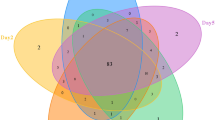Abstract
Culture-based analysis was employed in parallel with PCR amplification of 16S rDNA, coupled with denaturing gradient gel electrophoresis (DGGE), to profile bacterial species associated with different developmental stages of the pine false webworm (PFW), Acantholyda erythrocephala, a sawfly pest responsible for incidents of severe defoliation in commercially important tree plantations in North America. Culture-based analysis revealed that Pseudomonas spp. along with Bacillus sphaericus and Arthrobacter sp. were the predominant components of the microflora of the internal organs and identified life-stage-specific associations including Photorhabdus temperata with egg and larval samples and a Janthinobacterium sp. with eonymphs. PCR-DGGE confirmed the predominance of Pseudomonas spp. and B. sphaericus in the majority of samples but did not detect Arthrobacter sp., P. temperate, or Janthinobacterium sp. In contrast, DGGE revealed the presence of a Chryseobacterium sp. as the predominant component of the PFW micoflora at all life stages, with the exception of adults. This species had been infrequently cultured, at low levels, from a limited number of samples and the existence of a possible relationship between this bacterium and the PFW had gone unnoticed using the culture-based approach. Our findings highlight the advantages of applying a dual approach to the study of microbe-insect associations and demonstrate that the benefits of one system can be used to overcome some of the limitations of the other.

Similar content being viewed by others
References
Amann RI, Ludwig W, Schleifer KH (1995) Phylogenetic identification and in situ detection of individual microbial cells without cultivation. Microbiol Rev 59:143–169
Asaro C, Allen DC (2001) History of a pine false webworm (Hymenoptera: Phamphiliidae) outbreak in northern New York. Can J Forest Res 31(1):181–185
Bernardet JF, Vancanneyt M, Matte-Taillieza O et al (2005) Polyphasic study of Chryseobacterium strains isolated from diseased aquatic animals. Syst Appl Microbiol 28:640–660
Chow SL, Nicolson SW (2004) Insect physiological ecology. Oxford University Press, Oxford, pp 115–153
Dillon RJ, Dillon VM (2004) The gut bacteria of insects: non-pathogenic interactions. Annu Rev Entomol 49:71–92
Douglas AE (1998) Nutritional interactions in insect-microbial symbioses: aphids and their symbiotic bacteria Buchnera. Annu Rev Entomol 43:17–37
Duman JG (2001) Antifreeze and ice nucleator proteins in terrestrial arthropods. Annu Rev Physiol 63:327–357
Eribe E, Paster B, Caugant DA et al (2004) Genetic diversity of Leptotrichia and description of Leptotrichia goodfellowii sp. nov., Leptotrichia hofstadii sp. nov., Leptotrichia shahii sp. nov. and Leptotrichia wadei sp. nov. Int J Syst Evol Microbiol 54:583–592
Forney LJ, Zhou X, Brown CJ (2004) Molecular microbial ecology: land of the one-eyed king. Curr Opin Micro 7:210–220
Lacava PT, Parker J, Andreote FD et al (2007) Analysis of the bacterial community in glassy-winged sharpshooter heads. Entomol Res 37:261–266
Lyons DB (1988) Phenology and biometeorology of pine false webworm (Hymenoptera: Pamphilidae) and its parasitoid in Ontario. Ph.D. thesis. University of British Columbia, Vancouver
Lyons DB, Jones GC (2000) What do we know about the biology of the pine false webworm in Ontario? In: Lyons BB, Jones GC, Scarr TA (eds) Proceedings of a workshop on the pine false webworm, Acanthlyda erythrocephala (Hymenoptera: Pamphilidae). Toronto, Natural Resources Canada, pp 3–12
McIntosh D, Ji B, Forward BS et al (2008) Culture-independent characterization of the bacterial populations associated with cod (Gadus morhua L.) and live feed at an experimental hatchery facility using denaturing gradient gel electrophoresis. Aquaculture 275:42–50
Moore WEC, Moore LVH (1986) Genus Eubacterium Prèvot 1938. In: Sneath PHA, Priest FG, Goodfellow M, Todd G (eds) Bergey's Manual of Determinative Bacteriology, vol 2. Williams & Wilkins, Baltimore, pp 1353–1373
Muyzer G (1999) DGGE/TGGE a method for identifying genes from natural ecosystems. Curr Opin Microbiol 2(3):317–322
Olofson E (2000) Aetiology of melanized inclusions in the body cavity of Neodiprion sertifer (Geoffroy) (Hym, Diprionidae) adults. J Appl Entomol 124:293–298
Reeson AF, Jankovic T, Kasper ML et al (2003) Application of 16S rDNA-DGGE to examine the microbial ecology associated with a social wasp Vespula germanica. Insect Mol Biol 12:85–91
Xiang H, Wei GF, Jia S et al (2006) Microbial communities in the larval midgut of laboratory and field populations of cotton bollworm (Helicoverpa armigera). Can J Microbiol 52:1085–1092
Walker VK, Palmer GR, Voordouw G (2006) Freeze-thaw tolerance and clues to the winter survival of a soil community. Appl Environ Microbiol 72:1784–1792
Author information
Authors and Affiliations
Corresponding author
Rights and permissions
About this article
Cite this article
Zahner, V., Lucarotti, C.J. & McIntosh, D. Application of 16S rDNA-DGGE and Plate Culture to Characterization of Bacterial Communities Associated with the Sawfly, Acantholyda erythrocephala (Hymenoptera, Pamphiliidae). Curr Microbiol 57, 564–569 (2008). https://doi.org/10.1007/s00284-008-9243-4
Received:
Revised:
Accepted:
Published:
Issue Date:
DOI: https://doi.org/10.1007/s00284-008-9243-4




